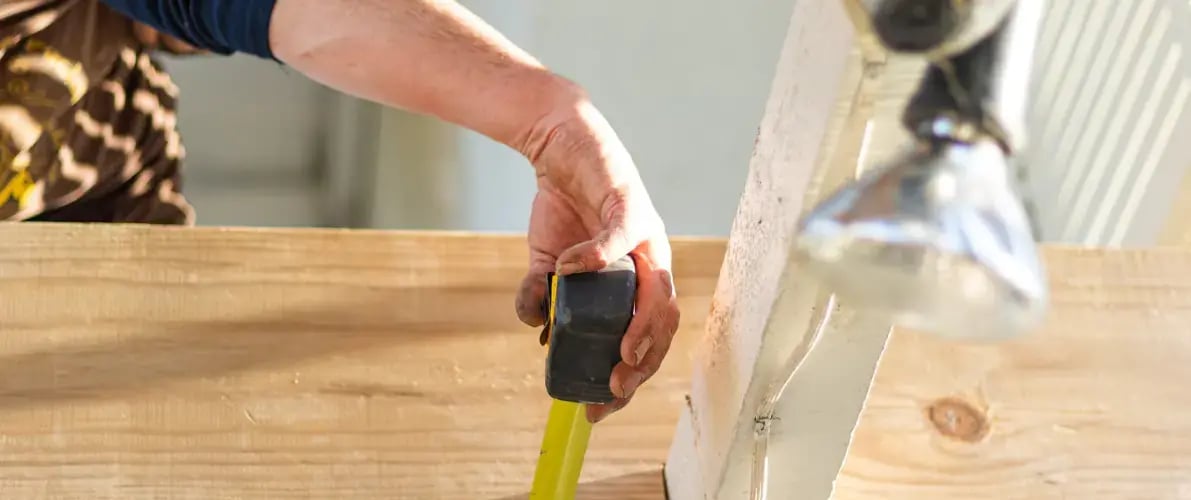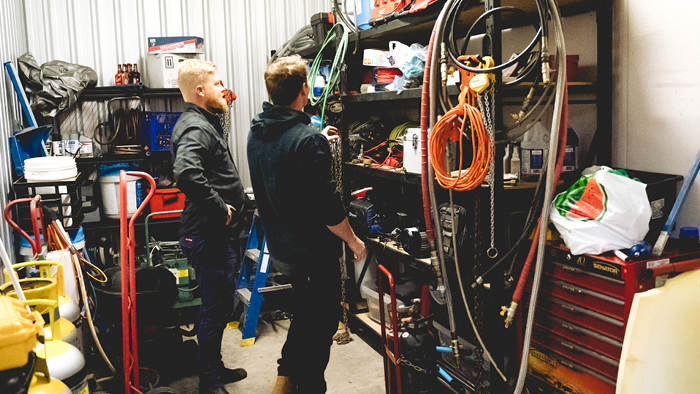How To Calculate the Cost of Building Materials
by Team Tradify, February 4, 2025

Table of Contents
Some tradespeople add a fixed percentage to their quotes, but that is an approximation, not a calculation. Materials are an essential part of the overall job cost, so getting your calculations right is important.
Knowing the exact cost of building materials will help you nail your quotes, stay within budget – and maintain a steady cash flow.
Ultimately, having all the right figures in play is key to achieving long-term success and profitability. Here’s everything you need to know to accurately calculate the cost of building materials.
- Process versus job costing – what’s the difference?
- What’s involved in job costing
- Calculating material quantities
- Tips for getting the right price for your building materials
- Calculating the cost of jobs, provide accurate quotes
- Quote quickly, win more work
- Best practice, make time for your financials
1. Process versus job costing – what’s the difference?
Before starting a new project, you need to figure out the build costs so you can send an accurate quote. This will also help you avoid cost blowouts and customer conflicts – both slippery slopes to losing business and reputation damage.
Going with your gut feeling or basing your costs on what you think competitors are charging isn’t enough. There are two different ways you can price a job – let’s break it down:
- Process costing means looking at the steps required to complete the job and assigning an average cost to each stage based on past projects. You then add the averages to the overall budget.
- Job costing means breaking down the specific labour and material requirements by looking at the details for each job. When you’ve calculated your costs, you add a markup to cover your operating costs (or overheads).
2. What’s involved in job costing
Job costing is a more rigorous and time-consuming process, but it usually yields a more precise estimate.
-
Labour costs
Work out how much it costs per day to have your employees on the job. More than just their hourly rate, this can also include pensions or superannuation, annual leave, and sick days.
Multiply that rate by the time you estimate the job will take. Keep in mind that you need to factor in training, material supply delays, weather interruptions and any onsite meetings.
-
Material costs
These costs are all the materials you need to do the job such as timber, steel, electrical wiring, fasteners or caulking. Don’t forget to include any equipment hire. You’ll also want to add a margin to cover deliveries, wastage, and scrap.
-
Overheads
Overhead costs include anything that isn’t directly related to the job, for example:
- Equipment maintenance
- Administration costs
- Vehicle expenses
- Office expenses
- Advertising
You can also take all your overhead costs for the year and divide them by the total number of hours on the job. That should equal what you add to your hourly rate.
If you’re not comfortable with equations, the best thing to do is to ask an accountant.
3. Calculating material quantities
To determine the cost of building materials, you first need to figure how much you need for each job. Here are some suggestions:
-
Get your calculator handy – whether it’s cement, bricks or steel, online calculators make it easy to estimate the right construction material quantities.
-
Alternatively, use a construction calculator – to figure out how much paint you need for a specific area, how steep a slope is or how much wood you need for a particular structure.
- Get help from a quantity surveyor – to estimate the material, labour and service costs for a building project.

4. Tips for getting the right price for your building materials
The pandemic has been a catalyst for a surge in construction projects, leading to material shortages, delays and increasing prices.
- In the US, building materials are up 19.4% from a year ago
- In the UK, the cost of materials rose by 20% in one year
- In Australia, reports predict annual construction costs will continue increasing more than 3% up to the end of 2023.
In general, the cost of building materials varies depending on your region and country, and in places like New Zealand, material costs have risen 25% over the past five years. Here are some pointers for making sure you get the best possible price for your building materials:
- Only pay for what you need.
Calculating the right quantity of materials for each job means you don’t unnecessarily overspend, and it helps keep any waste to a minimum too.
Learn about eco-friendly & sustainable building materials.
- Make sure you get the trade price for materials.
As a professional builder, you’ll likely have access to discounted trade prices for your building materials. Be sure to ask your suppliers.
- Know which merchants to target.
Remember to shop around, negotiate, and place purchase orders with whoever is offering the lowest price.
- Check availability and timeframes for delivery.
With the current building materials shortage, there can be long waiting times for some supplies – and sometimes, additional costs.
- Consider using second-hand materials.
Using second-hand building materials is good for the planet and your pocket, with second-hand bricks, reclaimed timber, and old window frames being a more affordable option.

5. Calculating the cost of jobs, provide accurate quotes
Now that you’ve worked out the quantity of materials you need, it’s time to pull together all your costs and work out how much to quote your client.
Here’s the winning formula – then we’ll break down each section:
- Cost per hour per employee x number of hours allocated to the job = labour allowance
- Labour allowance + materials costs = total cost
- Total cost + markup = total price to quote client
Use a charge-out rate calculator
Working out how much to charge per hour shouldn’t be a guesstimate. At the same time, you don’t need to be a mathematical whiz to find the correct numbers.
Our charge-out rate calculator takes the guessing out of the equation so you can get an accurate figure. It’s a straightforward process – you just need to be clear on the following points:
- Desired annual income
- Chargeable hours per year
- Income requirements
- Overheads
- Break-even analysis
- Profit margin
Want to learn more about this topic? Read our guide on how to calculate your charge-out rate or perform a small business break-even analysis.
Capture material price changes as they happen
Too often, tradespeople undercharge for materials because their supplier prices are out of date. On the other hand, take too long to ring around those suppliers for current prices and you’re wasting time that could be spent on the tools.
With Tradify, you can import a supplier price list within minutes and it’ll automatically update the prices of corresponding materials. That means when it comes time to quote for work, you can be confident that your material cost prices are correct – and you won’t lose money on the job.
6. Quote quickly, win more work
Once you’ve crunched the numbers, the final piece of the puzzle is sending your customers a clean, professional quote – as fast as possible. Electrician Matt Hill used to spend half a day handwriting a quote for each job, a process that cost him time and money. Using Tradify has changed all of that – here’s how:
- Improved quote turnaround. It takes Matt a fifth of the time to get a quote out, making him more responsive and more likely to land the job.
- Bundle costs together. Price kits speed up the quoting process by making it easy to select one master item instead of entering multiple items individually.
- Accessible on the go. You can create quotes from anywhere using any device, whether you’re on a job, in your van – even sitting on the couch.
- Simple workflows. Once a quote is accepted, you can schedule and start tracking the job with the press of a button.
- Automated follow-up. Quote reminder emails are triggered to automatically follow up on quotes that haven’t been responded to.
Optimise material costs by back costing
Back costing is an excellent way to ensure you’ve given the correct quote for a job and you’ve made a profit.
After a project has finished, assess the costs and compare them to your original quote to see how spot-on you were. Then use these insights to make any adjustments for future projects to maximise your profit.
Tradify makes back costing a breeze, allowing you to track profit and costs with our snapshot analysis, saving you a stack load of time when it comes to invoicing.

7. Best practice, make time for your financials
The devil is in the detail when it comes to calculating the cost of building materials. You’ve got to spend time thinking the project through, figuring out material quantities and ensuring you have updated supplier price lists. Only then will you be able to accurately calculate the total cost of a job.
Making sure you profit from every job can be a challenge at the best of times, and even more so with the rapid rise of material costs. That’s where Tradify makes life easier, helping you stay in control of your profitability – and avoid making costly mistakes.
Upload your supplier price lists and start sending accurate, professional quotes with Tradify. Start a free 14-day trial today.
Related articles

How To Keep Your Trade Business Running When You’re on Holiday

Digital Marketing for Small Businesses + Free Marketing Plan

5 Great Gift Ideas For Tradies
Give Tradify a go for free!
Save 10+ hours/week on business admin with the highest-rated job management software for tradespeople.
With free one-on-one training and phone support, it's never been easier to get started.



